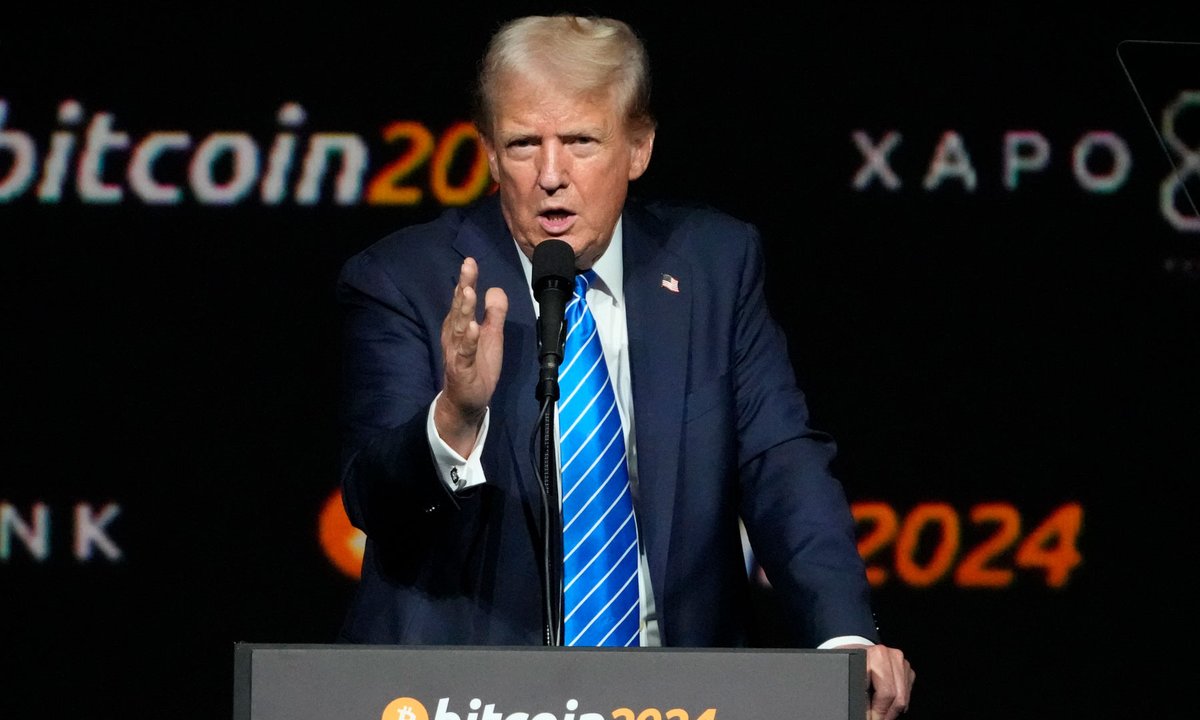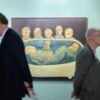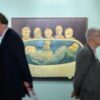
Last November, the artist Beeple held a US election night party complete with a hot dog-eating contest, screens displaying his impish political images and actors wearing uncanny rubber masks of political and tech leaders such as Kim Jong Un, Elon Musk and, of course, the two major parties’ presidential candidates—Kamala Harris and Donald Trump. The South Carolina-based digital artist famously became the third-most-expensive living artist at auction in 2021, when Christie’s sold his NFT (non-fungible token) Everyday: The First 5,000 Days for $69.3m. With that, Beeple was crowned the face of the crypto community’s efforts to disrupt the art market, introducing new types of transactions, artists and behaviour.
Much has changed since those halcyon days. “The NFT market is the least ambiguous picture you could possibly show in a PowerPoint,” says Amy Whitaker, an associate professor of visual arts administration at New York University and the co-author of The Story of NFTs: Artists, Technology and Democracy (2023). “It’s a diagonal line down from left to right, with a 97% contraction in trading volume.”
Crypto cheers
While right-wing figures such as Trump and Musk often appear in Beeple’s irreverent, vulgar caricatures, the artist and his election party guests exploded into cheers when Trump’s victory was announced. Their euphoria reflects the cryptocurrency community’s belief that it will enjoy a more favourable regulatory climate under a second Trump term.
The crypto industry’s leading Super Pacs (political action committees) poured more than $130m into Trump’s campaign, while Gary Gensler, the current chair of the Securities and Exchange Commission (SEC), became persona non grata for his enforcement of regulation against crypto. Binance, Coinbase and other crypto exchanges had sustained major losses as the SEC enforced existing laws rather than developing a new regulatory framework that made more exceptions for cryptocurrencies.
After Trump’s victory, the price of ethereum—the cryptocurrency that NFTs are typically traded in—and bitcoin surged. Trump has nominated Paul Atkins, a cryptocurrency advocate, to run the SEC, and picked David Sacks, a former PayPal executive, for the new position of crypto and artificial intelligence czar. Meanwhile Musk, the world’s richest man and backer of the cryptocurrency dogecoin, will co-direct the new Department of Government Efficiency (or Doge).
The art market’s NFT craze in 2021 was preceded by a crypto bull run and heralded by a massive purchase by a crypto entrepreneur. One might reasonably expect a second-wave NFT boom is on its way. But some experts believe an anticipated lack of regulatory enforcement in the crypto sector during Trump’s second term could kill off NFTs entirely.
Rohan Grey, a professor at Willamette University and the research director of the Digital Fiat Currency Institute, says the NFT market reached its previous, dizzying heights only because regulation targeted other crypto assets—namely, initial coin offerings (ICOs). An ICO is a form of funding through which a company issues a crypto-token that represents a stake in a company or project to interested investors. In 2017, ICOs exploded in popularity as start-ups and app developers began raising hundreds of millions of dollars’ worth of coins to fund their projects.
Grey says: “It was basically issuing shares without going through the share registration process, and it was so scammy that it was giving more established crypto money a bad name. Then came the regulatory pushback—which isn’t surprising considering that no one seemed to come up with a name that didn’t sound like IPO (initial public offering), which is, of course, regulated by the SEC. That’s when NFTs started coming up as a workaround.”
Unlike cryptocoins, NFTs are ‘non-fungible’—that is, unique. If you put 100 NFTs in a row, each one is different, whereas all cryptocoins are the same. Grey says: “So the logic went, ‘If we were doing shares, then all the shares would look the same, but each of these shares is unique.’”
By 2019, regulation and enforcement had ripened, with the SEC issuing guidance on when a digital asset qualifies as an investment contract and is therefore a security. The same year, the SEC fined Block.one, a blockchain company, $24m after it had raised billions through an ICO. A year later, the NFT market began to pick up steam.
Another core feature of NFTs—their artistic features—will make them even more difficult for the SEC to regulate. “There’s a content, meaning and expressive speech element to NFTs that isn’t present in other forms of the crypto market,” says Brian Frye, an artist and law professor at the University of Kentucky who focuses on intellectual property. “The NFT market has some benefits to the crypto world from a regulatory standpoint in so far as it’s a different group of people asserting different kinds of interests. This potentially gives the crypto crowd a lever that the regular kind of crypto market in currencies, coins and exchanges don’t necessarily get.”
Lost advantage
But if NFTs were useful to the crypto industry specifically because they were difficult to regulate, their use-case may be about to expire. Under Trump, the industry is anticipating an SEC that will be unmotivated to enforce existing regulatory frameworks at all.
Trump himself has sold four series of NFTs, the latest of which came out last August, raising millions of dollars for his campaign. One of the NFTs features an image of Trump dressed as a superhero with the caption ‘Crypto President’. Buyers could win prizes such as dinner and cocktails with Trump at Mar-a-Lago or a pair of his limited-edition golden sneakers. The element of chance led Robert Laplaca, a marketing lawyer, to suggest that Trump’s NFT promotion could be illegal.
According to Laplace: “‘While supplies last’ promotions are legal, but the important distinction here is that it’s not the original NFTs that have a limited supply; instead, it’s the additional special gifts. Because you have to make a purchase [of an NFT] for the chance to get one of these limited additional products, you run into lottery problems. Without a free/non-paying method to have a chance to win these additional awards, the promotion could be an illegal lottery.”
What does it mean for the sector that a presidential candidate was able to raise campaign funds in legally dubious ways using NFTs and cryptocurrency? For Whitaker, it is another NFT death knell.
She says: “What people really need for experimentation is clear structure, and clarity has less to do with governance than whether NFTs can be explored and developed without failing the Howey Test.” The Howey Test ascertains which transactions qualify as SEC-regulated investment contracts.
While the NFT market thrived at least in part because it offers a workaround to certain regulations, it is also this lack of regulatory enforcement that allowed the sector to be inundated with rug-pulls and Ponzi schemes. Cryptocurrencies are on the rise, but NFTs may be left behind as artefacts of untrustworthy crypto applications, much like ICOs before them.
That does not mean the crypto crowd is done with the art world. Auction houses such as Christie’s and Sotheby’s continue to organise sales of digital art and accept payments in crypto for some analogue lots—including Maurizio Cattelan’s The Comedian (2019), purchased in November by crypto investor Justin Sun for $6.2m at Sotheby’s. Museums have also been acquiring NFTs from artists such as Anne Spalter and the Ethiopian artist collective Yatreda .
“There were a lot of connections that were made between some of the best digital artists that were using NFTs and institutions, and so we’ve been seeing the rolling effect of that,” says Ryan Zurrer, a crypto venture capitalist and founder of the 1of1 Collection, which supports digital art initiatives in museums. He says: “95% of what was created in that 2017 to 2022 period still washes away to near zero. But that upper crust of 5% that’s surviving will go on to thrive in these coming years.”
This post was originally published on this site be sure to check out more of their content






